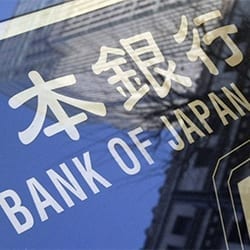Bank of Japan (BoJ) Governor Haruhiko Kuroda suggests that a new round of aggressive easing will begin at its monetary policy meeting next week, and more negative interest rates (NIR) are on the table. The first round of NIR raised suspicion from the likes of Bank of England Governor Mark Carney, Financial Times columnist Matin Wolf, and Credit Suisse economist Takashi Shiono that Japan is effectively engaging in exchange rate manipulation. The evidence suggests this to be true, a concerning matter if more NIR is to come.
Thus far, markets have not responded to NIR as expected, though several unusual factors may be the cause. Even without those factors, there are good reasons to doubt whether the domestic channels of monetary policy transmission can work for NIR in Japan. Most importantly, past extraordinarily loose monetary policy has not reliably activated the domestic real economy. Bank lending and risk-taking has expanded only modestly, and inflation expectations are declining. The impact of NIR on asset prices is weak and indirect at best. Even with quantitative easing, which has boosted asset prices, the wealth effect on consumption has been small, and high valuations have not induced firms to invest.
After a hopeful resurgence in 2013-14 in response to quantitative easing, fundamental economic signals turned very weak. GDP shrunk by minus 0.3 percent quarter-on-quarter during October-December in 2015 and inflation has hovered close to zero for over a year. Moreover, Moody’s managing director, Michael Taylor, reports “Japan’s [quantitative easing] has proven relatively ineffective in generating sustainable consumer price inflation or a pick-up in real wages.”
On the other hand, the exchange rate channel has worked for NIR, though you might not have noticed it. Right after the announcement of the NIR policy, the JPY/USD exchange rate jumped by more than 3 yen (greater than 2.5 percent), from around 118.5 yen to more than 121.5 yen, within several hours (see Figure 1). The movement was large compared with the effects of comparable recent Bank of England or Federal Reserve Board statements.
Figure 1. Trade-by-trade movement (tick data) of the yen-dollar rate on Jan. 29, 2016
Since the initial drop, the yen has strengthened significantly, seemingly counterintuitively (see figure 2). In the days after the announcement, however, the market seems to have decided that the NIR policy was in fact a very weak step. Rates moved only from positive 0.1 percent to negative 0.1 percent — less than a quarter point — and applied to very few types of bank accounts. The modesty of the move revealed the BoJ’s reluctance to use this tool, and the strong public reaction against NIR made further moves even less likely. The market came to interpret the meek NIR move as, effectively, a monetary tightening relative to prior expectations. At around the same time the Federal Reserve delivered dovish comments on US rates, and the yen began to strengthen. More recently, safe haven flows have sustained the trend.
In short, NIR did have the expected impact on exchange rates. More NIR at the next BoJ meeting may have a disproportionate impact because it would show markets that the BoJ is not so timid after all.
Why does the BoJ want to lower the exchange rate? Most obviously it seeks improvement in export competitiveness — the beggar-thy-neighbor effect. Moody’s Analytics econometric model estimates that a 1 percent depreciation of the yen leads to a 13 percent gain in export value to the United States. Depreciation also makes imports more expensive, helping the BoJ to boost inflation.
Further, the exchange rate comes with its own asset valuation channel. The Nikkei and the dollar-yen rate remain strongly linked. In our calculation, the correlation between the two is more than 0.96 percent from December 2014 to April 2016 (see Figure 2). The two have remained highly linked since the BoJ adopted negative interest rates. Some of that correlation is due to competitiveness effects, but most comes simply because exporting firms’ overseas profits are worth more in yen terms, so-called valuation changes.
Figure 2. Nikkei stock index and the yen-dollar rate
So is this manipulation? It isn’t very far from it. Prime Minister Shinzo Abe recently disavowed exchange rate intervention, but Finance Minister Taro Aso wants to continue to threaten markets with it. In recent months the authorities have been engaging in quasi-intervention measures like rate checks.
Certainly, the direct action of the BoJ only occurs in domestic markets, but how different is intervention in foreign exchange from domestic monetary policy that only works through the exchange rate? This is a gray area with no clear answers. As much as NIR expands the boundaries of feasible monetary policy, Japanese NIR policy can be said to be exploring the limits of internationally acceptable monetary policy.
Russell Green is the Will Clayton Fellow in International Economics at Rice University’s Baker Institute.
Masaaki Yoshimori is a contributing expert at the Baker Institute.


